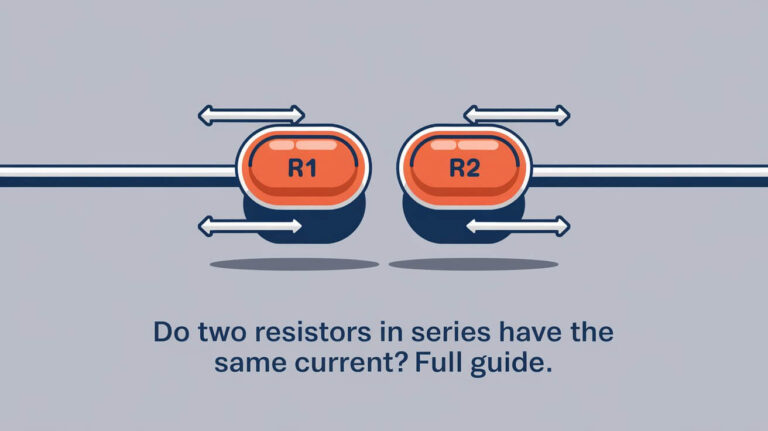What is a Resistor? Understanding Types, Uses, and Selection

A resistor is a passive electrical component that limits or regulates the flow of electric current in a circuit. Essential in nearly all electrical devices, resistors prevent components from overheating, allow precise voltage control, and enable efficient operation of circuits. By creating resistance, resistors dissipate energy as heat, which is critical for controlling and stabilizing circuits. In this article, we’ll explore resistors in detail—from how they work and types available, to choosing the right resistor for various applications.
Introduction to Resistors
Resistors are fundamental in electronics, serving as a barrier to current flow. By limiting current, they play a key role in protecting sensitive parts of a circuit from excessive power that could cause damage. Without resistors, electrical circuits would be unpredictable, leading to potential malfunctions and reduced lifespans of devices. Let’s break down what makes resistors indispensable.
Basic Principles of Resistance
What is Resistance?
Resistance, measured in ohms (Ω), is the property of a material that restricts the flow of electric current. In the context of a resistor, this characteristic helps to control current and voltage within a circuit. Ohm’s Law, a foundational equation in electronics, defines the relationship between voltage (V), current (I), and resistance (R):
V=I×RV = I \times RV=I×R
According to Ohm’s Law, a resistor’s value directly affects the amount of current that flows for a given voltage.
Units and Symbols
The symbol for resistance is the Greek letter omega (Ω). Resistor values range widely, from fractions of an ohm to millions of ohms (megaohms, MΩ), depending on the required function within a circuit. Circuit diagrams typically represent resistors with either a jagged line (zigzag) or a rectangular block.
How Resistors Work
Resistors restrict the movement of electrons, causing energy to be converted into heat. This conversion is essential in applications like current limiting and voltage division, where excess energy must be dissipated for safe operation. A resistor’s effectiveness depends on its resistance value and power rating:
- Resistance Value: Determines the level of resistance applied.
- Power Rating: Defines how much heat a resistor can safely handle, often specified in watts (W).
Types of Resistors
Resistors come in various forms to meet different circuit needs. Below are the main types:
Fixed Resistors
Fixed resistors have a set resistance value that does not change, making them ideal for applications requiring stable resistance. Common types include:
- Carbon Film Resistors: These are affordable and widely used, though they may produce electrical noise, limiting their use in high-frequency circuits.
- Metal Film Resistors: Known for high accuracy and low noise, metal film resistors are ideal for precision circuits.
- Wire-Wound Resistors: Used in high-power applications, wire-wound resistors consist of a coil of resistive wire around an insulating core, suitable for handling high current.
Variable Resistors
Variable resistors allow for resistance adjustment, making them versatile components in electronics:
- Potentiometers: Often used for volume control, they feature three terminals and provide an adjustable voltage divider.
- Rheostats: Similar to potentiometers but with two terminals, rheostats are ideal for current regulation.
- Trimmers: Small, adjustable resistors designed for fine-tuning circuit parameters in applications where adjustments are seldom needed.
Special Resistors
Special resistors have unique functions based on environmental factors:
- Thermistors: Change resistance with temperature fluctuations, used in temperature sensing applications.
- Photoresistors: Also known as light-dependent resistors (LDRs), they change resistance based on light exposure, ideal for light-sensitive circuits.
- Varistors: Protect circuits from voltage spikes by altering resistance under high-voltage conditions.
Surface-Mount and Through-Hole Resistors
Resistors come in two main mounting types:
- Surface-Mount Device (SMD): SMD resistors are compact and designed for automated, high-density assembly on circuit boards.
- Through-Hole: These resistors have leads that pass through a circuit board, ideal for prototyping and high-power applications requiring robust connections.
Construction and Materials
Carbon Film, Metal Film, and Wire-Wound Resistors
Each resistor type uses specific materials to optimize performance:
- Carbon Film: Composed of carbon film on a ceramic substrate, these resistors are cost-effective but may produce electrical noise.
- Metal Film: Made from a metal alloy layer, they offer high precision, low noise, and stability across various temperatures.
- Wire-Wound: Built from resistive wire coiled around an insulating core, wire-wound resistors can handle high power loads.
Comparing Resistor Materials
Selecting the right resistor material is crucial as each offers different advantages:
- Carbon Film: Affordable with moderate precision, suitable for low-cost applications.
- Metal Film: Higher precision with excellent temperature stability, used in audio and sensitive measurement circuits.
- Metal Oxide: Known for durability and high-temperature resistance, often used in harsh environments.
Resistor Configurations in Circuits
Series Configuration
When resistors are placed in series, their values add up. The total resistance is the sum of each individual resistor. This configuration is often used to control current across different components, as the resistance increases and the current decreases.
Parallel Configuration
In parallel, the total resistance decreases. This configuration is useful in circuits needing high current flow, as it allows multiple pathways for electricity. The total resistance can be calculated using the formula: 1RTotal=1R1+1R2+1R3+…\frac{1}{R_{Total}} = \frac{1}{R_1} + \frac{1}{R_2} + \frac{1}{R_3} + …RTotal1=R11+R21+R31+…
Mixed Series-Parallel Circuits
Some circuits require a combination of series and parallel resistors. Mixed configurations enable specific resistance values, useful in more complex circuits for precise current and voltage control.
Color Coding and Value Identification
The Resistor Color Code
Resistor values are often indicated by colored bands. The 4-band color code is common in standard resistors, while precision resistors use 5- or 6-band codes. Here’s a general breakdown:
- 4 Bands: The first two bands denote digits, the third is a multiplier, and the fourth indicates tolerance.
- 5- and 6-Band: Similar to 4-band but with an extra digit band and, in 6-band, a temperature coefficient band.
Tolerance and Precision
Tolerance indicates how much a resistor’s actual resistance can vary from its labeled value. Precision resistors, with tolerances as low as 0.1%, are essential for applications where accuracy is crucial.
Applications of Resistors
Current Limiting
Resistors help limit current to safe levels, preventing component damage and ensuring stable operation. This application is particularly common in circuits with LEDs or sensitive ICs.
Voltage Division
Resistors in series can create a voltage divider, dividing input voltage into smaller, manageable outputs for various parts of a circuit.
Pull-up and Pull-down Resistors
In digital circuits, pull-up and pull-down resistors maintain logic states, ensuring stability in microcontroller inputs and outputs.
High-Power Applications
Power resistors can withstand significant current flow, ideal for high-power circuits, motor controls, and power supplies.
Choosing the Right Resistor for a Circuit
Factors to Consider
Selecting a resistor involves balancing several criteria:
- Resistance Value: Determined by the circuit requirements.
- Tolerance: Important for precision circuits.
- Power Rating: The resistor’s ability to dissipate heat, critical in high-power applications.
- Material: Carbon for affordability, metal for precision, or wire-wound for power.
Typical Scenarios and Examples
For example, in LED circuits, resistors prevent excessive current, protecting the LED from burning out. In audio circuits, resistors with low noise and tight tolerance are preferred to maintain signal clarity.
Resistor Innovations and Trends
Miniaturization
The demand for smaller, more efficient circuits has led to the widespread use of SMD resistors. Their tiny size allows for compact, high-density circuit boards in devices like smartphones and wearables.
Advances in Tolerance and Heat Dissipation
Precision resistors with minimal tolerance deviation are increasingly important in fields like instrumentation and medical equipment, where reliability is paramount.
Sustainability in Resistor Production
As electronics evolve, manufacturers are exploring eco-friendly materials and energy-efficient production methods for resistors.
FAQs About Resistors
What Are Resistors Made Of?
Most resistors are made of materials like carbon, metal film, or metal oxide, each suited for specific applications based on accuracy, temperature stability, and power requirements.
Do Resistors Have Polarity?
Resistors are non-polar, meaning they can be connected in either direction within a circuit.
Can Resistors Fail?
Yes, resistors can fail due to excessive heat, overloading, or manufacturing defects. Signs of failure include discoloration, burning smell, and interrupted circuit flow.
Conclusion
Resistors are a fundamental component in electronic circuits, providing essential control over current and voltage. With various types, materials, and configurations, they offer tailored solutions for diverse applications, from simple household devices to high-precision medical equipment. Understanding resistor types, functions, and selection criteria allows for safer and more efficient circuit design, ensuring electronic devices operate reliably and effectively.




